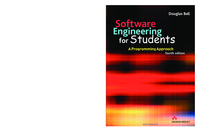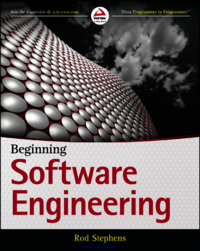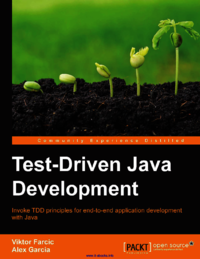Etiqueta "software engineering"
Se han encontrado 6 Coincidencias.png)
Head-First Software Development
146 Visitas | 262 Descargas | 2013-09-17 04:56:59 | rmillo
Even the best developers have seen well-intentioned software projects fail - often because the customer kept changing requirements, and end users didn't know how to use the software you developed. Instead of surrendering to these common problems, let "Head First Software Development" guide you through the best practices of software development. Before you know it, those failed projects will be a thing of the past. With its unique visually rich format, this book pulls together the hard lessons learned by expert software developers over the years. You'll gain essential information about each step of the software development lifecycle - requirements, design, coding, testing, implementing, and maintenance - and understand why and how different development processes work. This book is for you if you are: tired of your customers assuming you're psychic. You'll learn not only how to get good requirements, but how to make sure you're always building the software that customers want (even when they're not sure themselves); wondering when the other 15 programmers you need to get your project done on time are going to show up. You'll learn how some very simple scheduling and prioritizing will revolutionize your success rate in developing software; confused about being rational, agile, or a tester. You'll learn not only about the various development methodologies out there, but how to choose a solution that's right for your project; and, confused because the way you ran your last project worked so well, but failed miserably this time around. You'll learn how to tackle each project individually, combine lessons you've learned on previous projects with cutting-edge development techniques, and end up with great software on every project. "Head First Software Development" is here to help you learn in a way that your brain likes...and you'll have a blast along the way. Why pick up hundreds of boring books on the philosophy of this approach or the formal techniques required for that one? Stick with "Head First Software Development", and your projects will succeed like never before. Go on, get started...you'll learn and have fun. We promise.

Software Engineering for Students
Software Engineering for Students. A Programming Approach
124 Visitas | 146 Descargas | 2016-01-29 15:54:47 | josedaniel
This book explains the different principles, techniques and tools that are used in software development. These are the mainstream methods that are currently used throughout the industrialized world. This book doesn’t present easy answers about the value of these techniques. Indeed, it asks the reader to make an assessment of the techniques. This is what the software engineer has to do – now and in the future – choose the appropriate techniques for the project in hand from the multiplicity of techniques that are on offer.

Beginning Software Engineering
Software Engineering
130 Visitas | 181 Descargas | 2016-01-29 15:58:04 | josedaniel
This book describes software engineering. It explains what software engineering is and how it helps produce applications that are effective, fl exible, and robust enough for use in real?world situations. This book won’t make you an expert systems analyst, software architect, project manager, or programmer, but it explains what those people do and why they are necessary for producing high?quality software. It also gives you the tools you need to start. You won’t rush out and lead a 1,000?person effort to build a new air traffi c control system for the FAA, but it can help you work effectively in small?scale and large?scale development projects. (It can also help you understand what a prospective future boss means when he says, “Yeah, we mostly use Scrum with a few extra XP techniques thrown in.”)

Site Reliability Engineering
How Google Runs Production Systems
73 Visitas | 66 Descargas | 2016-04-07 18:59:36 | AMorales
The overwhelming majority of a software system's lifespan is spent in use, not in design or implementation. So, why does conventional wisdom insist that software engineers focus primarily on the design and development of large-scale computing systems? In this collection of essays and articles, key members of Google's Site Reliability Team explain how and why their commitment to the entire lifecycle has enabled the company to successfully build, deploy, monitor, and maintain some of the largest software systems in the world. You'll learn the principles and practices that enable Google engineers to make systems more scalable, reliable, and efficient—lessons directly applicable to your organization.

Test-Driven Java Development
Invoke TDD principles for end-to-end application development with Java
109 Visitas | 130 Descargas | 2016-10-05 19:46:05 | josedaniel
This book is written by developers for developers. As such, most of the learning will be through code. Each chapter will present one or more TDD practices and we'll try to master them by solving katas. In karate, kata is an exercise where you repeat a form many times, making little improvements in each. Following the same philosophy, we'll be making small, but significant improvements from one chapter to the next. You'll learn how to design and code better, reduce time-to-market, produce always up-to-date documentation, obtain high code coverage through quality tests, and write clean code that works.

Design patterns explained simply
Patrones de diseño de software
63 Visitas | 35 Descargas | 2021-12-31 04:44:44 | josedaniel
This book isn't an introduction to object-oriented technology or design. Many books already do a good job of that. This isn't an advanced treatise either. It's a book of design patterns that describe simple and elegant solutions to specific problems in object-oriented software design. Once you understand the design patterns and have had an "Aha!" (and not just a "Huh?" experience with them, you won't ever think about object-oriented design in the same way. You'll have insights that can make your own designs more flexible, modular, reusable, and understandable - which is why you're interested in object-oriented technology in the first place, right?
Contribuir
Usted puede contribuir con Libros UCLV, es importante para nosotros su aporte..
Contribuir